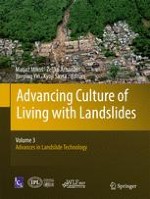2017 | OriginalPaper | Chapter
Synthetic Water Repellent Soils for Slope Stabilization
Authors : Shuang Zheng, Sérgio D. N. Lourenço, Peter J. Cleall, Stuart W. Millis, Angel K. Y. Ng, Ting Fong May Chui
Published in: Advancing Culture of Living with Landslides
Publisher: Springer International Publishing
Activate our intelligent search to find suitable subject content or patents.
Select sections of text to find matching patents with Artificial Intelligence. powered by
Select sections of text to find additional relevant content using AI-assisted search. powered by
Abstract
 Water repellent soils, or non-wettable soils, are described as having delayed wetting of the soil surface and water infiltration, and have been studied by soil scientists and agriculturists for decades. Soil water repellency induced by wildfire is believed to be a major trigger of post-fire debris flows, by changing the hydrological characteristics of the slopes, the rainfall infiltration is delayed, leading to the increased surface runoff and eventual soil mass movement. On the other hand, the potential applications of water repellent soils in the field of slope engineering have also been recognized recently. Due to their ability to inhibit water infiltration while remaining gas permeable, water repellent soils are considered to be promising fill materials and impermeable barriers. Soil water repellency is widely observed to occur in nature because of wildfire and organic matter, while in the laboratory, it can be induced by coating the soil particles with low surface energy substances such as silane compounds. An advantage of synthetic water repellent soils is that the level of water repellency is adjustable (from very wettable to extremely water repellent), and therefore the rate of infiltration can be controlled in various scenarios. Since intense rainfall and subsequent infiltration significantly contribute to fill and natural slope failures, water repellent soils have proved to be effective in hindering the infiltration and generation of excess pore pressure and therefore could increase the overall factor of safety during rainstorms. Landfill cover is another potential application of water repellent soils.
Water repellent soils, or non-wettable soils, are described as having delayed wetting of the soil surface and water infiltration, and have been studied by soil scientists and agriculturists for decades. Soil water repellency induced by wildfire is believed to be a major trigger of post-fire debris flows, by changing the hydrological characteristics of the slopes, the rainfall infiltration is delayed, leading to the increased surface runoff and eventual soil mass movement. On the other hand, the potential applications of water repellent soils in the field of slope engineering have also been recognized recently. Due to their ability to inhibit water infiltration while remaining gas permeable, water repellent soils are considered to be promising fill materials and impermeable barriers. Soil water repellency is widely observed to occur in nature because of wildfire and organic matter, while in the laboratory, it can be induced by coating the soil particles with low surface energy substances such as silane compounds. An advantage of synthetic water repellent soils is that the level of water repellency is adjustable (from very wettable to extremely water repellent), and therefore the rate of infiltration can be controlled in various scenarios. Since intense rainfall and subsequent infiltration significantly contribute to fill and natural slope failures, water repellent soils have proved to be effective in hindering the infiltration and generation of excess pore pressure and therefore could increase the overall factor of safety during rainstorms. Landfill cover is another potential application of water repellent soils.